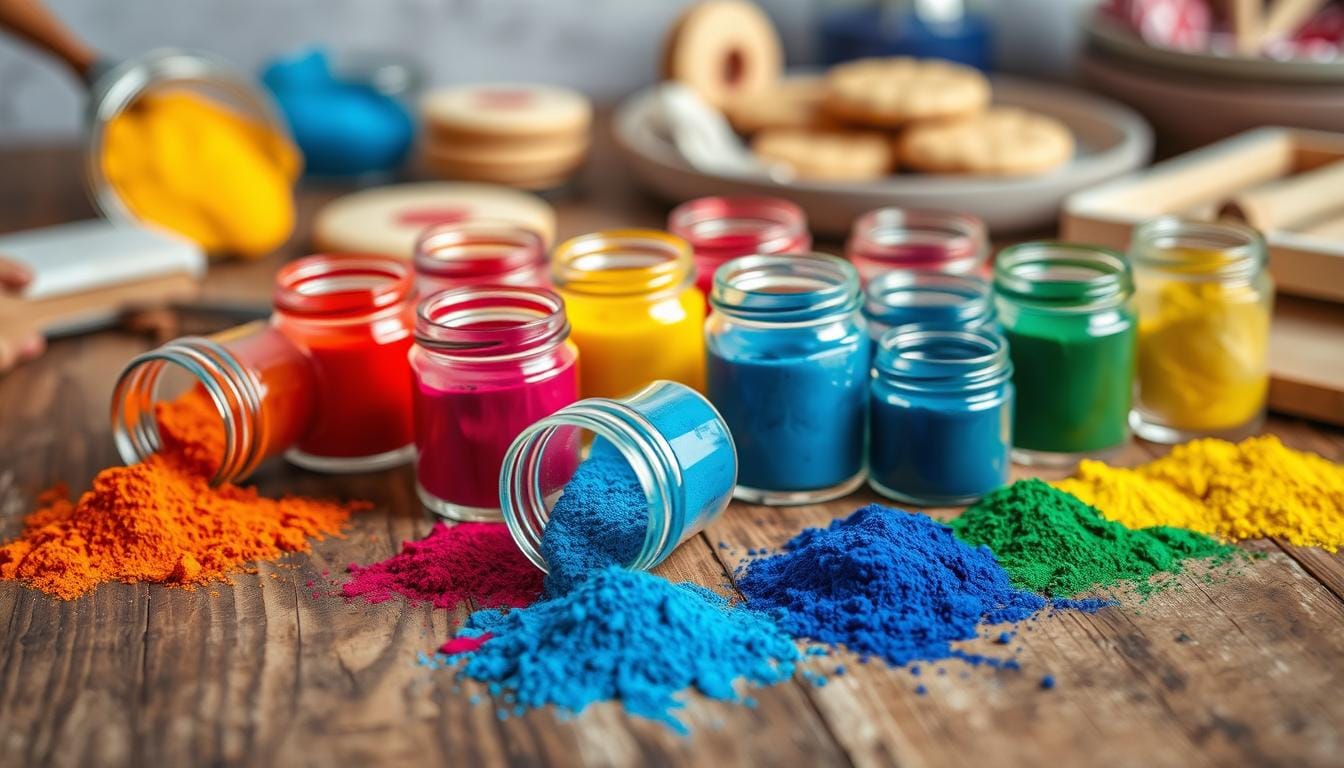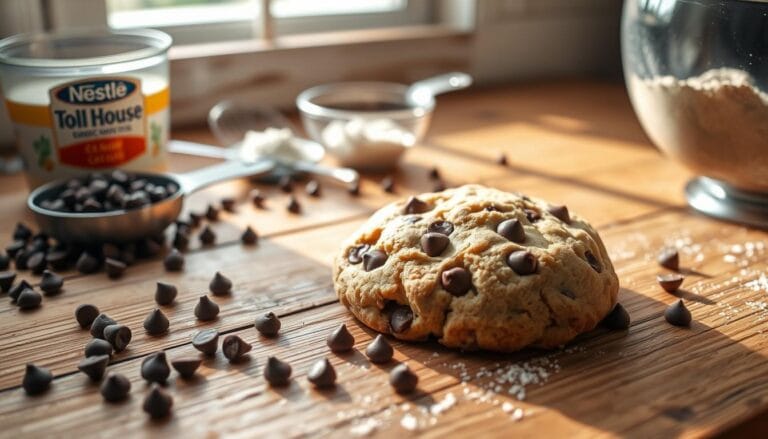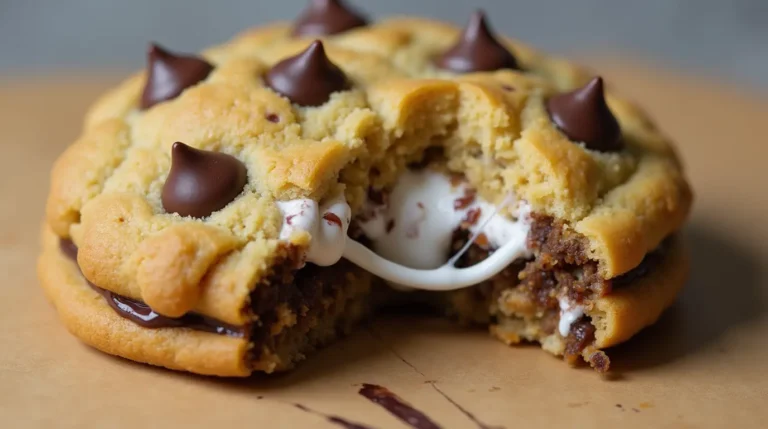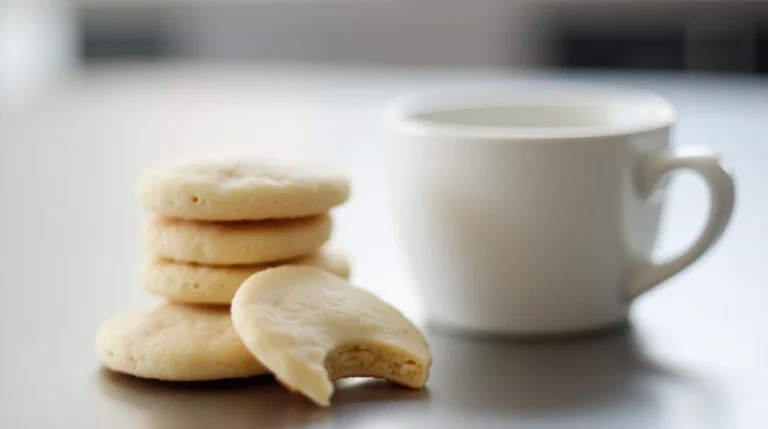Colorful ingredients in some cookie recipes
Using colorful ingredients in some cookie recipes can make them stand out. These ingredients add a pop of color and make the cookies look great. You can make cookies that taste amazing and look stunning too.
Natural colors from veggies and fruits are better than artificial dyes. They make your cookies healthier and more vibrant. By using these ingredients, you can make treats that wow your loved ones.
Adding colorful ingredients to your baking is fun and creative. It lets you express yourself through your cookies. You can make special cookies for any event or just for fun.
Table of Contents
Key Takeaways
- Using colorful ingredients in some cookie recipes can add a pop of color and make the cookies more visually appealing.
- Natural colors derived from vegetables and fruits are a healthier alternative to artificial dyes for colorful cookie recipes.
- Incorporating colorful ingredients into your cookie recipes can create unique and delicious treats.
- Using colorful ingredients can be a fun and creative way to express yourself through baking.
- Colorful ingredients can be used to create color cookies that are perfect for any occasion.
- Experimenting with different colorful ingredients can help you create unique and delicious cookie recipes.
Understanding the Role of Color in Cookie Making
Color in baking colorful cookies is more than just looks. It can change our mood, hunger, and how we taste things. For example, red can make us hungry, while blue can calm us down. Knowing how color affects us is key in cookie making.
Different colors can make us feel different ways. Warm colors like red, orange, and yellow are full of energy. They’re great for colorful cookies for big celebrations.
Cool tones such as blue, green, and purple evoke a sense of tranquility. Choosing the right colors for your color cookies can set the mood for any event. Whether it’s a birthday or a holiday, the right colors can make it special.
Visual Appeal and Psychology of Food Colors
The look of colorful cookies is linked to color psychology. Some colors can make us hungry or happy. By knowing color psychology, you can make color cookies that look good and feel right.
Impact on Taste Perception
Colors can change how we taste things. A red color cookie might taste sweeter than a blue one, even if they’re the same. Our brains link colors to tastes, which can alter how we experience flavor.
Color and Marketing Appeal
In cookie making, color is key for marketing. Colorful cookies catch our eye and make your products stand out. By picking the right colors for your color cookies, you can build a brand that people remember and like.
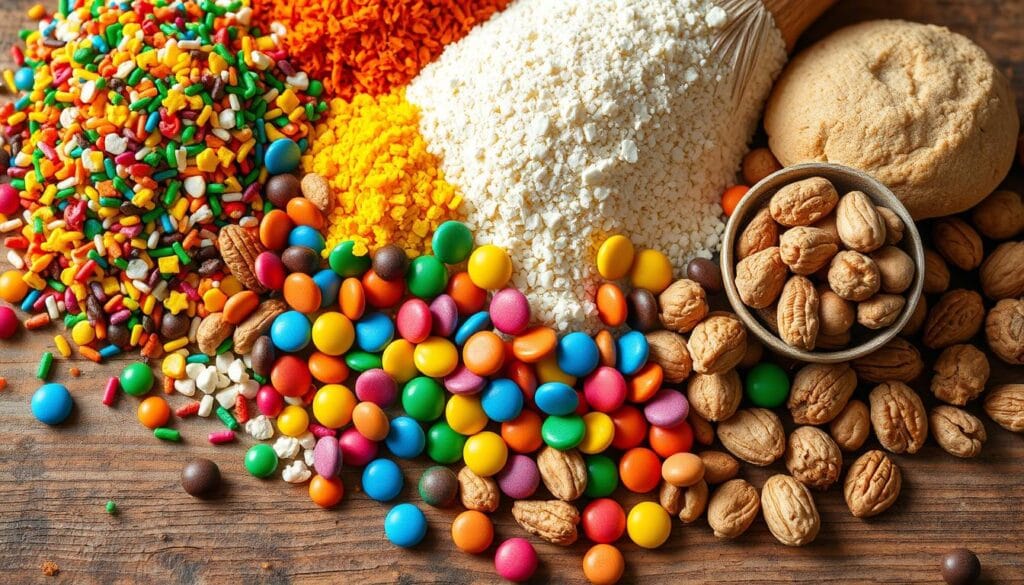
Natural vs Artificial Food Coloring Options
When coloring your cookies, you can choose between natural and artificial options. Natural coloring, like beet powder, turmeric, and matcha, gives a unique, subtle hue. Yet, it might not be as intense or last as long as artificial coloring.
Artificial coloring, though, offers a brighter, steadier color. But, some research links it to health issues. Natural food coloring is a safer choice, but finding the right shade can take some trial and error. For instance, beet powder is needed in larger amounts to get a red color compared to artificial options.
Here are some natural coloring options:
- Beet powder for a pink or red color
- Turmeric for a yellow color
- Matcha powder for a green color
Your choice between natural and artificial coloring depends on what you value more. If you prefer a natural, softer look, natural food coloring is ideal. For a bold, consistent color, artificial might be your best bet.
Popular Natural Colorful Ingredients in Some Cookie Recipes
Adding a pop of color to your cookies is easy with natural ingredients. Fruit-based colors like raspberry and strawberry make your cookies both beautiful and tasty. These ingredients also give your cookies a unique flavor and texture.
Beet powder, matcha, and turmeric are popular choices. Beet powder turns cookies red, matcha makes them green, and turmeric turns them yellow. These ingredients are not only natural but also add a special taste to your cookies.
Fruit-Based Colors
Fruit-based colors are a fantastic way to color your cookies. Raspberry or strawberry puree can make them pink or red. You can also use blueberries or cranberries for purple or pink hues.
Vegetable-Derived Pigments
Vegetable pigments are another excellent choice for coloring cookies. Beet powder gives a deep red, while turmeric makes them yellow. These natural pigments also bring a unique flavor to your treats.
Spice-Based Colors
Spices can add a warm, cozy color to your cookies. Cinnamon or nutmeg can make them brown or tan. These spices not only color your cookies but also add a special flavor.
Using natural ingredients to color your cookies is a great idea. There are many options, so you can make a unique and tasty cookie for any event. Whether you choose fruit, vegetable, or spice-based colors, your cookies will be both stunning and delicious.
| Ingredient | Color | Flavor |
|---|---|---|
| Raspberry puree | Pink/Red | Sweet/Tart |
| Beet powder | Deep Red | Earthly/Sweet |
| Turmeric | Yellow | Warm/Spicy |
Working with Artificial Food Colors
Adding color to your cookies can be fun. You can use artificial food colors or food coloring. Start with a small amount of artificial food coloring in your dough or icing. Mix well.Adding more is simpler than trying to reduce an excess amount.
When using artificial food colors, choose a high-quality one made for baking. This ensures vibrant and consistent colors. Be careful not to over-color, as it can look bad.Begin with a small quantity and increase it gradually if necessary.
Here are some tips for using artificial food colors:
- Use a few drops of coloring at a time, as it’s easier to add more than it is to remove excess.
- Mix the coloring into the dough or icing thoroughly to ensure an even distribution of color.
- Be aware of the color changing as the cookies bake.
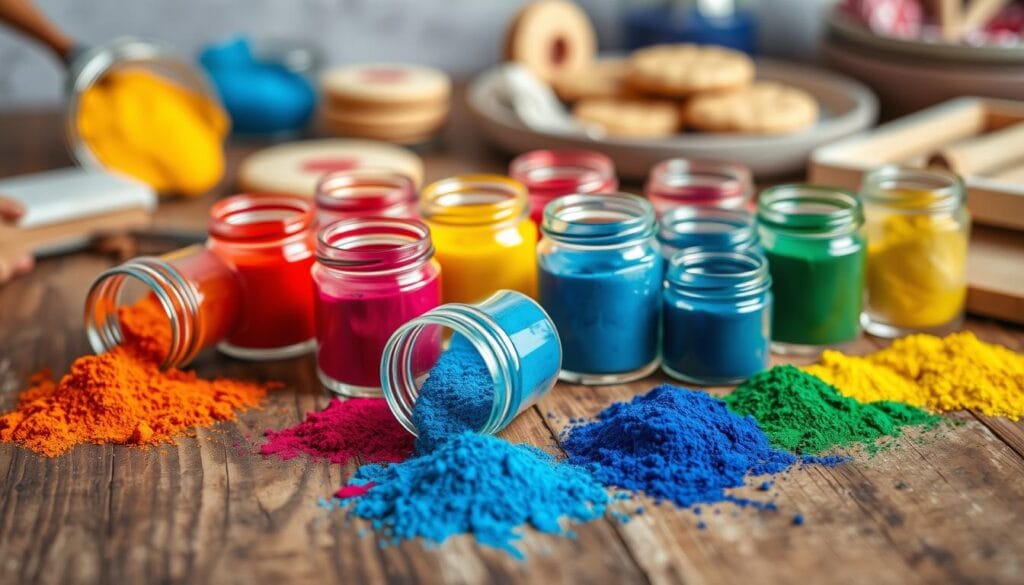
Remember, artificial food colors have their limits. Some colors may not be as bright, and others may fade or bleed. Knowing these limitations helps you get the best results.
| Color | Recommended Amount |
|---|---|
| Red | 5-10 drops |
| Blue | 5-10 drops |
| Yellow | 5-10 drops |
| Green | 5-10 drops |
By following these tips, you can make your cookies look professional. Artificial food colors are great for adding color and fun to your baking.
Essential Tools for Adding Color to Cookies
Adding color to cookies requires the right tools. You’ll need cookie making tools like mixing equipment, application tools, and storage solutions. These tools help you make colorful cookies just right.
You’ll start with a good rolling pin, like the Joseph-Joseph. Also, a baking sheet that’s at least 18″ x 13″ is essential. A 6-quart stand mixer can also be helpful for mixing big batches of dough.
For detailed designs, you’ll need piping bags and tips. Brands like Wilton, CK, and Genie’s Dream offer great meringue powder for royal icing.
- Mixing equipment, such as a stand mixer or hand mixer
- Application tools, such as piping bags and tips
- Storage solutions, such as airtight containers or baking sheets
With the right tools, you can make a variety of colorful cookies. They’ll surely impress your loved ones.
Techniques for Even Color Distribution
To get an even color in your cookies, you need to know some techniques. One way is marbling, where you mix colors to get a swirly pattern. This method can make simple or complex designs.
Layering is another technique. It involves adding layers of dough or icing to stack them. This can make detailed designs and patterns. You can mix marbling with layering for more interest.
Here are some tips for even color distribution:
- Use a consistent mixing method to mix colors well.
- Put on a thin, even layer of dough or icing to avoid unevenness.
- Let cookies cool completely before serving to stop colors from bleeding.
| Technique | Description |
|---|---|
| Marbling | Mixing two or more colors together to create a unique, swirly pattern |
| Layering | Applying layers of colored dough or icing to create a stacked effect |
Getting an even color is all about technique and patience. With practice, you can make cookies that look like they were made by a pro.
Common Challenges When Adding Colors to Cookies
Working with colorful cookies can be tricky. You might face challenges like color bleeding, fading, and texture issues. These problems can ruin your cookie’s look and feel.
Color bleeding happens when colors mix too much. Fading occurs when colors lose intensity while baking. Texture problems can make cookies too soft or hard. These issues can be frustrating, but knowing the causes helps you avoid them.
Using top-quality food coloring and the right baking techniques can help. This way, you can get the colors and texture you want.
- Color bleeding: This occurs when the colors mix or spread unevenly, resulting in an unappealing appearance.
- Fading during baking: This happens when the colors fade or become less intense during the baking process.
- Texture problems: This can occur when the addition of colors affects the texture of the cookies, making them too soft or too hard.
Knowing about these challenges lets you tackle them. This way, you can make stunning, colorful cookies for any event.
Safety Considerations and Food Allergies
When using colorful ingredients in cookie recipes, safety and allergies are key. The Food Allergy Research and Education (FARE) says 32 million Americans have food allergies. It’s important to know about common allergens and how to avoid them.
Labeling and telling people about food allergies is a big part of food safety. The Food Allergen Labeling Consumer Protection Act (FALCPA) requires labels to list allergens like milk and soy. Many people with allergies read labels closely and choose their foods carefully.
Some colorful ingredients can cause serious allergic reactions. For example, annatto and carmine can lead to anaphylaxis. It’s vital to handle these ingredients safely and label them clearly to protect consumers.
To lower the risk of allergic reactions, follow these tips:
- Read labels carefully to identify possible allergens
- Prevent cross-contamination with common allergens
- Use warning labels for possible cross-contact
By focusing on food safety and being careful, you can make tasty and safe cookies. Always be aware of allergens and take steps to avoid allergic reactions.
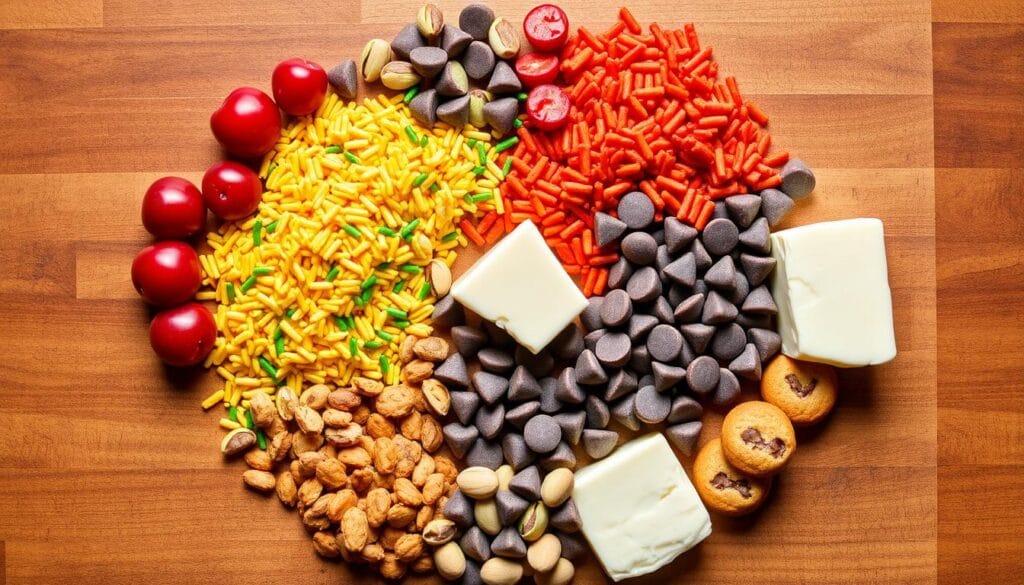
Creative Color Combinations for Seasonal Cookies
When baking seasonal cookies, the right colors matter a lot. Colorful cookies inspire unique and festive treats for any time. Think about the season and the event you’re baking for. For instance, winter holidays like Christmas and Hanukkah need cool colors like blue and silver. Spring holidays like Easter and Mother’s Day are best with bright, pastel colors.
Some favorite color mixes for seasonal cookies are:
- Red and green for Christmas
- Pastel colors like pink, blue, and yellow for Easter
- Orange and black for Halloween
- Use red, white, and blue to celebrate the 4th of July.
Using these colors and adding your own twist, you’ll make colorful cookies that wow everyone. Don’t hesitate to try new things. That’s what makes baking seasonal cookies so enjoyable!
Tips for Photography and Presentation
Photography is key when showing off your colorful cookies. Think about the lighting, how you arrange your cookies, and how you style them. For the best results, use natural light by shooting near a window or outdoors. Experiment with various angles to add creativity and interest to your photos.
For cookie photography, a simple background is important. Use a white or light surface or a themed backdrop. Adding props like sprinkles or icing can make your photos pop.
Here are some tips for styling your cookies: * Mix colors and textures for depth and interest * Play with shapes and sizes for a unique look * Use a reflector or extra light to highlight your cookies’ colors and details * Be creative and try new things – it’s all part of the fun!
By following these tips and practicing, you’ll show off your colorful cookies beautifully. Whether on social media or in your home, your photos will impress everyone.
Conclusion: Making Your Cookie Creations Stand Out
Using colorful ingredients can really make your cookies pop. You can use natural dyes like beet powder or matcha green tea. Or, you can try artificial colors for a bold look. The choices are endless, whether you’re making Italian rainbow cookies or Jell-O treats.
Color psychology is key in making cookies appealing. Warm colors like red and orange can make people hungry. Cool colors like blue and purple might make them less hungry. Knowing this can help you pick the right colors for your cookies.
Keep being creative with your ingredients and toppings. Try using rainbow sprinkles or edible glitters. By using color, your cookies will surely catch everyone’s eye.
FAQ
What is the role of color in cookie making?
Color is key in making cookies look good and taste great. Different colors can change how we feel and what we taste. It also plays a big role in marketing, helping us decide what to buy.
What are the differences between natural and artificial food coloring options?
Natural colors come from fruits, veggies, and spices. They’re healthier but might not be as bright as artificial colors. Artificial colors are more vibrant but can have downsides.
What are some popular natural colorful ingredients that can be used in cookie recipes?
For natural colors, try using beet, pomegranate, and berry. You can also use spinach, turmeric, and matcha. Spices like cinnamon, cocoa, and saffron work well too.
How do I work with artificial food colors effectively?
Use artificial colors carefully to get the right shade. Don’t overdo it. Mixing them with natural ingredients can create amazing cookie designs.
What are the essential tools needed for adding color to cookies?
You’ll need mixing tools and ways to apply the color, like piping bags. Also, keep your colors in good condition with proper storage.
How can I achieve even color distribution in my cookies?
Try marbling or layering to get even colors. This helps avoid color bleeding and ensures your cookies look great.
What are some common challenges when adding colors to cookies?
Issues like color bleeding and fading can happen. Knowing how to fix these problems is key to making colorful cookies that taste good.
What safety and allergy considerations should I be aware of when using colorful ingredients?
Watch out for common allergens like nuts and soy. Make sure to avoid mixing them with other ingredients to keep your cookies safe.
How can I create creative color combinations for seasonal cookies?
Try out holiday colors and special occasion palettes. Mixing colors in new ways can make your seasonal cookies stand out.
How can I effectively photograph and present my colorful cookies?
Good lighting and styling are key. They help show off your colorful cookies in the best way possible.
There are no reviews yet. Be the first one to write one.
